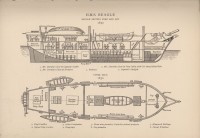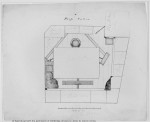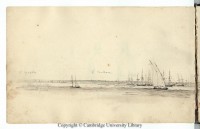 Charles Darwin boarded the HMS Beagle in December of 1831 as a self-funded gentleman naturalist (Josiah Wedgwood II, son of the potter/industrialist and Charles’ uncle by marriage, actually did the funding) on what was supposed to be a two-year survey of the South American coast. He wound up spending five years on board circumnavigating the globe. Darwin was 22 years old and fresh out of Cambridge when his epic voyage began. While the Beagle crew focused on surveying the coasts, Darwin’s job was studying the local flora, fauna and geology. Even though he was an amateur who had only ever put together a beetle collection before, he proved adroit at collecting specimens, over the years amassing a great quantity of them from plankton to Megatherium fossils.
Charles Darwin boarded the HMS Beagle in December of 1831 as a self-funded gentleman naturalist (Josiah Wedgwood II, son of the potter/industrialist and Charles’ uncle by marriage, actually did the funding) on what was supposed to be a two-year survey of the South American coast. He wound up spending five years on board circumnavigating the globe. Darwin was 22 years old and fresh out of Cambridge when his epic voyage began. While the Beagle crew focused on surveying the coasts, Darwin’s job was studying the local flora, fauna and geology. Even though he was an amateur who had only ever put together a beetle collection before, he proved adroit at collecting specimens, over the years amassing a great quantity of them from plankton to Megatherium fossils.
On the Origin of Species was published in 1859, 23 years after the Beagle’s return to England, but the things he saw and the extensive notes and journal he wrote documenting his trip would be invaluable to his understanding that species are not immutable, but rather evolve over time through a process of natural selection. An essential element of Darwin’s growth from talented amateur to scientist was the research library on the Beagle. There were 404 books on board, mostly non-fiction (one exception Darwin is known to have read was a Spanish translation of a racy French novel by Antoine-Toussaint Desquiron de Saint-Agnan about the adultery trial of Queen Caroline, estranged wife of King George IV), almost all of them the property of the ship’s young captain Robert FitzRoy.
 The books were kept in cases in the poop cabin at the ship’s stern. Darwin was quartered in the poop cabin, which means for five years he lived in this library. Little wonder, then, that there are obscure notes in his journals that can only be explained by identifying the book referenced. However, the catalogue of the library was lost and the books themselves were dispersed when the Beagle returned home in 1836.
The books were kept in cases in the poop cabin at the ship’s stern. Darwin was quartered in the poop cabin, which means for five years he lived in this library. Little wonder, then, that there are obscure notes in his journals that can only be explained by identifying the book referenced. However, the catalogue of the library was lost and the books themselves were dispersed when the Beagle returned home in 1836.
Now a team of researchers led by John van Wyhe, a historian of science at the National University of Singapore, have compiled and digitized every last known title from the Beagle’s library.
Among the titles are all 20 volumes of the Encyclopedia Britannica, seven volumes of the Natural History of Invertebrate Animals by Jean-Baptiste Lamarck, and James Cook’s three-volume account of a Pacific Ocean voyage in the 1770s. […]
Reconstructing the library provides a more complete picture of Darwin’s world during the expedition. “Darwin literally lived in the library for five years,” said van Wyhe. “The science of his day was already quite sophisticated. All these geology books and all these books on fossils. Darwin could build on what was already known and what had come before.” […]
The books onboard were identified through a number of methods including letters sent between crew members and their families, lines in Darwin’s notebooks and his surviving book collection. The final number of books digitised for the project is close to a number stated by Robert FitzRoy, captain of the HMS Beagle. In a letter to his sister during an earlier voyage on 16 March 1826, FitzRoy wrote, “I flatter myself I have a complete library in miniature, upwards of 400 volumes!”
Here is the complete Beagle library catalogued by subject, here catalogued by title. There are a total of 195,000 pages in the library with more than 5,000 illustrations.
 If you’d like to see some of the sights Darwin saw during his voyage, you’ll enjoy another digitization project: Cambridge University’s scanning of the sketchbooks filled by the Beagle’s artist, Conrad Martens. He documented the sights with lightning drawings, most of them quick pencil sketches with some watercolors, during his altogether too brief time on board the ship. He joined the Beagle crew in November of 1833 at Montevideo and left after they reached Valparaiso in August of 1834 due to budgetary constraints. Leaf through Sketchbook III here and Sketchbook I here. (Those are in date order, despite the counterintuitive numbering.)
If you’d like to see some of the sights Darwin saw during his voyage, you’ll enjoy another digitization project: Cambridge University’s scanning of the sketchbooks filled by the Beagle’s artist, Conrad Martens. He documented the sights with lightning drawings, most of them quick pencil sketches with some watercolors, during his altogether too brief time on board the ship. He joined the Beagle crew in November of 1833 at Montevideo and left after they reached Valparaiso in August of 1834 due to budgetary constraints. Leaf through Sketchbook III here and Sketchbook I here. (Those are in date order, despite the counterintuitive numbering.)
[youtube=http://youtu.be/8D1K22Rbc20&w=430]
:yes: because you are telling everyone what it is all about